#film critic
Text
The level of media comprehension of Oppenheimer is so ridiculously terrible.
149 notes
·
View notes
Text

#film#letterboxd#movies#film critic#funny#tweet#twitter#screenshot#cinema#movie review#cinemetography
61 notes
·
View notes
Text
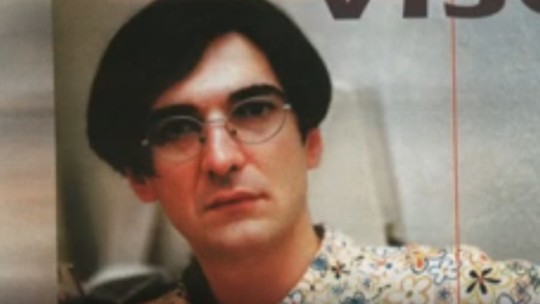
Dejan Nebrigić (deceased)
Gender: Male
Sexuality: Gay
DOB: 29 December 1970
RIP: 29 December 1999
Ethnicity: White - Serbian
Occupation: Activist, film critic, writer
Note: Was known as the initiator of the first trial of homophobic discrimination in Serbia. He was one of the founders of the LGBT movement in Serbia.
#Dejan Nebrigić#Dejan Nebrigic#lgbt history#lgbt rights#gay rights#male#gay#1970#rip#historical#white#serbian#activist#writer#film critic#critic#first
63 notes
·
View notes
Text

#tom hardy#venom#venom 2018#venom let there be carnage#eddie brock#eddie brock x venom#gay#gaycel#mlm yearning#mlm#I watched both movies back to back and they are amazing. it’s so gay you don’t even understand how obsessed I am#film critic#film criticism#venom 2018 review#symbrock
45 notes
·
View notes
Text
50 notes
·
View notes
Text
“I THINK THEY WENT AND CLOOOONNNEEEDDD TYROOOONNNNNEEEEE! CLOOOONNNEEDDD HIM!”🎶 When I tell y’all this movie had me like 😳😬😭🤣😭, I MEAN it, okay?! Like, Slick Charles, Fontaine, and Yo-Yo had me rolling THE ENTIRE TIME! But also, on a deeper level, I like how the fate of the Black community was left on those who everyone would’ve counted out and/or deemed problematic: the pimp, the drug-dealer, and the sex worker. Most of the time, depending on the lens, these people are deemed community miscreants and are heavily side-eyed. However, no one ever takes into account these people’s lives; the people and events that make up their everyday experiences in order for them to have ended up where they are in their lives and in society. They weren’t dealt the best of life’s cards and they were making due like everyone else in their community. It wasn’t until Fontaine seemingly came back from the dead that they knew more sinister-than-usual things were at work. If you enjoyed Jordan Peele’s “Get Out,” you will definitely enjoy “They Cloned Tyrone”!
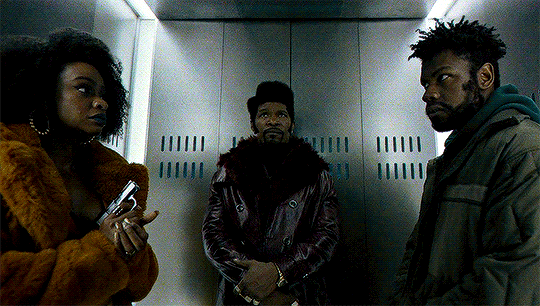
P.S. I really loved how the time setting was 1970s x early 2000s! The costume department did their thing and I want me-sized replicas of Slick Charles’ coat and Yo-Yo’s entire outfit in this scene!
#miscellaneous#jay#they cloned tyrone#they cloned tyrone spoilers#black tumblr#black girls who blog#black girls of tumblr#doaom#blackgirlbloggers#film critic#film critique#blerd#erykah badu#black fashion#black fandom
69 notes
·
View notes
Text
Samurai Champloo Review
What the hell even is a 'champloo' anyways? Ever since one fateful Passover seder, where my older cousin told me about this series, I've wondered about it. Its certainly not English, and though a quick Google search could give me my answer, the mystery of it all kept this show on my radar for nearly a decade. Its not often that a show with a title as puzzling as this get popular, especially enough for my slacker cousin to recommend it to me. With a recommendation like that, though, I knew there was something special about it.
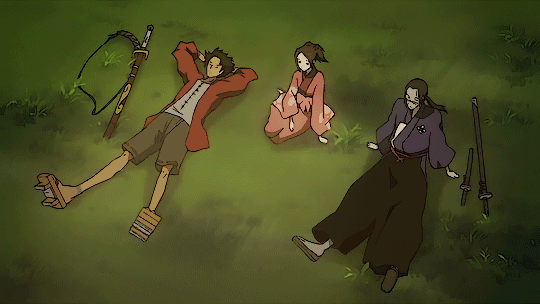
Samurai Champloo is a strange breed. Created in 2004 by Masaru Gotsubo, and animated by defunct studio Manglobe, the series follows a trio of miscreants on a journey to find a mysterious samurai. Along the way, they dodge the law, fight assassins, and discover how hard it is to be a minority in a changing world.

Champloo's biggest draw is it's style. The series features a modern-style Edo that keeps the historical dress and architecture, but adds a contemporary kick everywhere else. The opening alone sets the tone perfectly: sharply colored characters, juxtaposed onto paper-like backgrounds, moving to a hip-hop flow. Its stylish, like an old-school music video, and draws you in in seconds with its funky beat and striking visuals. Its the perfect opening, and things only get cooler from there.
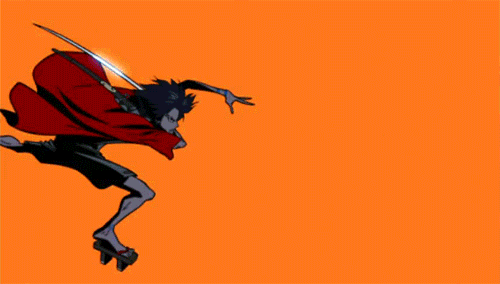
The Edo of this anime features a mix of traditional Japanese and modern North American styles, presented in a way that sets it apart from the rest. Its a show where you might find a samurai sword fight set to record scratches, or characters wistfully embarking on a journey while hip-hop music plays in the background. Early episodes use these scratches in the soundtrack as editing cues, cross-cutting between actions at the sound to create a wholly unique experience. It can't be overstated how much the musical styles of this anime make the viewing experience shine.

On top of that, much of the content of the show's episodes takes pages from a more modern handbook. One episode has the main trio caught up in the world of graffiti, as two brothers compete to see who can 'tag' the most dangerous places. Another has them play against American traders in a overly-violent game of baseball. All the while, characters talk with modern slang, ditching formalities and keeping with the tone the soundtrack sets. All this combined creates a historical anime that feels surprisingly contemporary, despite the obvious.
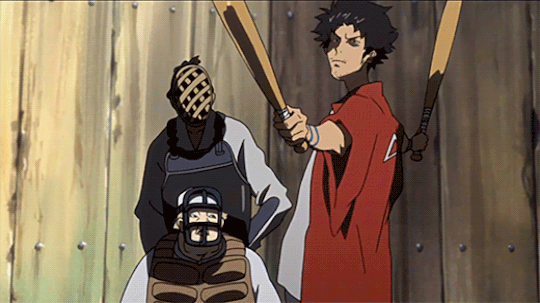
Over the course of the show's 26 episodes, we follow a main trio of characters as they journey to find a mysterious samurai who smells of sunflowers. The trip is long, and each episode usually features the gang stopping somewhere and getting involved in a stranger's problems, usually learning some moral or getting a lead on their quest afterwards. Its not often for series as mature as these to be episodic, given how seriously they take their plots, but here, it works well.
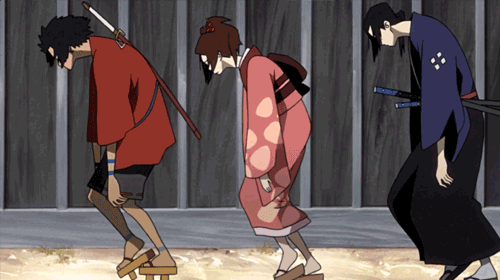
Every episode feels like another step along their journey, whether it be an eating contest in a big city, or hunting down a pick-pocket who stole their wallets. The series also does an excellent job at making the journey feel long, often referring back to the places the characters have been so far to keep track of it. You could actually track the trio's journey with a real life map if you wanted, since all the places they visit are historical, and probably still exist. Maybe someone out there has even tried their journey in real life...?

An anime is only as interesting as its main characters, and this one certainly has an interesting cast. The series stars three characters, who together, always find a way to screw things up in the most hilarious ways. First, there's Fuu, a young woman who meets the other two characters when they burn her workplace down, and enlists them to help find the samurai who smells of sunflowers. The show pulls no punches with her, often having her be the butt of the joke just as much as her companions. She's loud, whiny, naïve, and often eats the most out of all of them. Yet, she's usually the one that stops fights, is the voice of reason in all this show's chaos, and shows kindness to everyone she meets, even someone who tried to kill her. Though the other characters might play her off as another nagging woman, Fuu's right more often than not, and is a valuable member of the team.

Next is Jin, a ronin with a cool attitude. He's the level-headed one of the trio, often keeping to himself instead of jumping into arguments like the others. His cold exterior hides some pretty deep traumas, which were exciting to learn more about as the story developed. Characters like him are often stereotyped as unfeeling swordsmen, yet beneath all the sullen glances and reclusive body language, he grows to care about his companions more than any sense of pride.
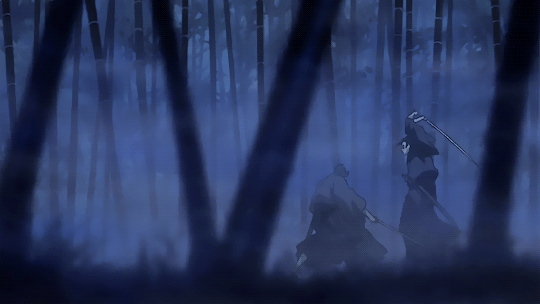
Lastly, there's Mugen, the wild vagrant. His reckless fighting style, love for battle, and unquenchable pride endeared him to me pretty quickly, making him an easy choice as favorite. Compared to Jin and Fuu, Mugen is an old-school tough guy, a shonen protagonist aged up a decade and thrown backwards a couple hundred years. Like Jin, he initially is quite guarded, but learns to express himself little by little, eventually revealing his tragic backstory. Though, to be fair, most of his self expression comes in the form of violence or threats, but I'm not here to judge him.

Together, these three form a simple comedy trio, and get into trouble at every turn on their journey as they learn to tolerate each other. From start to finish, the trio struggle to get along peacefully, but that's what makes their dynamic worth watching. Mugen and Jin's mutual hatred, balanced out by Fuu's persistence, is what keeps them going. Depending on what episode it is, they take turns being the 'straight man', keeping the dynamic fresh and free of stale tropes.

At the heart of this anime, though, is its theme of identity in a changing world. Throughout the series, the trio encounter various minority groups along their journey, and learn about their unique struggles. One episode has them protecting a secret Dutch immigrant, taking him on a tour of the city while they dodge immigration officers. When the man reveals that he fled his home country because of homophobia, it doesn't feel out of place or poorly handled. His queerness is just as much a part of his character arc as his foreign-ness, and though the show makes a few light-hearted jabs at his accent and obvious visual difference, it takes the rest of his identity rather seriously. This character, while only in the show for an episode, is just one of many minority characters in this series that is handled well, showing that a series doesn't have to be disrespectful to be historical.

Another major theme in this series is death, and the acceptance of it. Being an action series, its pretty obvious that a lot of characters die, but what's interesting is how other characters deal with those deaths. Many side characters who the trio befriend on their journey are dealing with loss in some way, whether it be a husband, sibling, child, or something else. We witness how their grief drives them, such as with Fuu, or various other characters in the series. In a world such as the one in this series, death is commonplace, but a healthy acceptance of it is unfortunately less so. Each encounter with death in the series opens up new discussions about it, and often had me pondering what these characters might do next, or how I would deal with their situations.

In the end, though, Samurai Champloo is a fascinating series that brings a unique blend of Eastern and Western styles to make a truly memorable viewing experience. It's hip-hop soundtrack pairs beautifully with flashy and quick-paced sword fighting, creating a simultaneous modern-historical vibe to it all. Its characters have an enjoyable dynamic that kept me coming back day after day for more, which inevitable led to disappointment upon discovering how short this series is. If we lived in a perfect world, this would have at least an extra season, but unfortunately, perfect this world ain't.

But hey, at least I can spend my Pink Halloween (read: Valentine's Day) knowing that Fuu is valid, Mugen is gender, and Jin defintely got pegged in that one episode.

#anime and manga#anime review#film critic#review#anime#anime critique#animation#animated series#samurai champloo#otakucore
20 notes
·
View notes
Text
Poor Things Movie Review
Brought back to life by an unorthodox scientist, a young woman runs off with a lawyer on a whirlwind adventure across the continents. Free from the prejudices of her times, she grows steadfast in her purpose to stand for equality and liberation.
Since the beginning of his career, Yorgos Lanthimos has been pushing the boundaries of filmmaking. He is unafraid to handle difficult themes and complicated subjects with his strange aesthetic. So when he decides to adapt a whimsical Victorian science fiction novel that explores the complexities of what it means to be a woman, I would be down immediately. However, I wish I didn’t get my hopes so high for Poor Things as I am left deeply conflicted. On one hand, it is a technological achievement for Lanthimos. The world-building and the aesthetics of the film are beautiful. But on the other is an alarming and problematic story that is framed as female empowerment.
A mad scientist (Willem Dafoe) discovers a dead pregnant woman (Emma Stone) floating in the River Thames. Using his Frankenstein methods, he revives the woman by replacing her brain with that of her unborn child. As the weeks and months go by, her speech begins to become more coherent and her motor skills more refined. When she discovers masturbation, her “father” drafts up a contract for her to be married to his assistant (Ramy Youssef). However, before the marriage, she runs off with the lawyer (Mark Ruffalo) where she discovers her sexuality and the reality of human nature. From this synopsis, it sounds like a modern retelling of Mary Shelly’s “Frankenstein”. However, Poor Things is more of a horror story than Frankenstein will ever be.
Throughout Poor Things, we witness Bella (Emma Stone), be groomed, sexually assaulted, and r*pe by men. However, instead of framing these atrocities for what they are, it is framed as female empowerment as she experiences her sexual awakening. As previously stated, Bella has the brain of a literal child, thus causing her to be emotionally immature and mentally handicapped, despite having the body of a fully grown woman. Many men immediately see her mental capacity and take full advantage of her. For example, when Duncan (Mark Ruffalo) arrives to draft up the marriage contract, he immediately notices that Bella is mentally handicapped, so he sexually assaults her. However, instead of framing it as a crime, Bella enjoys it and furthering her sexual awakening. Then the next thing you know, she runs away with her groomer, despite the fact she can barely put together a full sentence. However, her grooming does not end there. During a low point, she is manipulated by a Madam of a brothel, to sell herself to make some coin. But instead of framing this situation as a cautionary tale of selling yourself for money, it's framed as female empowerment as she is owning her sexuality. Despite the Madam being fully aware that she is mentally handicapped.
I don’t know about you, but if this does not make your skin crawl, I don’t know what I could say to you. This is a disgusting portrayal of feminism, as it frames these disgusting scenes of abuse and r*pe as sexual exploration. Poor Things is a r*pe fantasy of what men think female empowerment is, as it sexually exploits and sensationalizes Bella Baxter’s journey. From the uncomfortable close-up of Emma Stone experiencing orgasmic pleasure, to the sheer amount of fully nude shots Stone had compared to her male counterparts, is disgusting. I am fine with sex in film, but here it is so uncomfortable and unnecessary. Bella is reduced to nothing more than an experiment and a sex toy for men, as the film primarily focuses on her physicality and her relationships with men rather than showing her autonomy or resilience to sexism. Furthermore, by the end of the film, you wonder what it is saying. What I got was that the only way a woman can be enlightened, empowered, and strong is by having a lot of sex with other people. No offense but that comes across as a man's version of feminism.
Now within this r*pe fantasy, there are moments in Poor Things where it becomes classically feminist. While Bella is traveling on a boat to Alexandria she meets Martha (Hanna Schygulla) and Harry (Jerrod Carmichael). Unlike the rest of the film, Martha challenges Victorian-era norms as she exhibits a strong sense of independence and intelligence, unafraid to assert herself in a male-dominated society. While Harry acknowledges her intelligent wit and autonomy. Not once do they treat Bella as a sexual object. Together they teach Bella philosophy, literature, and human nature. Thus empowering her mind and spirit as she discovers there are more pleasures to life than sex. She learns of the mutual respect and admiration they have for one another, thus she begins to challenge her views of Victorian gender roles. Furthermore, when Bella is working in the brothel, she develops a close relationship with her co-workers highlighting the bonds between women. It’s a perfect highlight of feminine strength. However, these scenes are few and far in-between. I wish Poor Things would have explored these areas of feminism, as it shows that women are more than sexual objects. But sadly today feminism believes the only way women can be empowered is by having a lot of sex or by turning them into a man (it would have been funny if the baby was a boy).
To further add to the positives, I mostly enjoyed the performances, but I don’t think they are as groundbreaking as many people consider them to be. Emma Stone gives a very interesting performance. She is a very charismatic and versatile actor, which clearly shows in her performance when studying her body language and mannerisms But when studying her performance more, it does come across as a stereotype of someone who is mentally disabled. Her character is one-dimensional and her struggles and resilience seem to be non-existent in her performance. Whether this was writing, direction, acting, or all of the above, I expected more out of her than this stereotypical portrayal of someone who is mentally handicapped. Mark Ruffalo gives the standout performance in Poor Things. He is hysterical as his pathetic manchild of a character. However, an element missing from his performance that would have been a great extra layer would have been to frame his character for the sexual predatory that he is. Willem Dafoe is good here, but nothing really special. He is wasted as his character feels one note not only in writing but in theme. He never confronts his unethical Frankenstein methods, which is a massive waste of an opportunity. I greatly enjoyed the presents from Hanna Schygulla and Jerrod Carmichael, and I wished they were in the film more.
Furthermore, as with all Yorgos Lanthimos films, you know they will be technically spectacular. The production and costume design will fully immerse you into this Steampunk fantasy. The costumes are intricate and delicately textured, which feels both old and futuristic. The production design feels both old and futuristic with the flying rail cars to the Victorian interiors. The cinematography is beautiful with pastel-like colors that fill every frame. Furthermore, the score is unique and ties perfectly into Lanthimos’s aesthetics.
Yorgos Lanthimos’s Poor Things presents a troubling array of issues that undermine its potential. If Bella had been a fully grown adult (both mentally and physically) who had just been sheltered her whole life, with predatory characters being framed as predatory characters, and less of the male gaze, I most likely would have enjoyed Poor Things. However, because Bella is a child who is being sexually exploited, whatever themes Poor Things tries to tell are immediately tainted by the film's predatory nature. It lacks the nuances of feminism and female empowerment, as it misunderstands what it is to be a woman. It is a shallow and distorted depiction of women’s agency and struggles told through the eyes of a man.
My Rating: C-
#film#cinema#movies#movie#filmmaking#filmmaker#moviemaking#moviemaker#cinephile#cinematography#film community#film is not dead#film review#movie review#film critic#movie critic#poor things#emma stone#yorgos lanthimos#margaret qualley#oscars#willem dafoe#mark ruffalo
25 notes
·
View notes
Text
'Leo' Review
#Leo Review: "The team balanced middle-school humour w heartfelt lessons to make this a well-rounded feature for the whole family. The songs are the principal aspect of this film bc you can thread many ideas with lyrics that can connect to the audience."
By: Amanda Guarragi
There is something special about an animated feature that can speak to children and adults. The ability to educate children about life and how to express their feelings while making it relatable for adults is no easy feat. Every adult has gone through something, and it has stemmed from childhood. Films that tell a universal coming-of-age story will affect everyone…

View On WordPress
#Adam Sandler#animated feature#Bill Burr#blogger#Cinema#Entertainment#Film Critic#Film Reviews#Films#Leo Netflix#movie reviews#Movies#Netflix Film#Reviews#Writer
24 notes
·
View notes
Text


LIFE, February 24, 1927. Reviewer Robert E. Sherwood panned Harold Lloyd's THE KID BROTHER in the same article.
#film critic#film criticism#robert e sherwood#silent comedy#buster keaton#the general#1920s#1927#life magazine
13 notes
·
View notes
Text
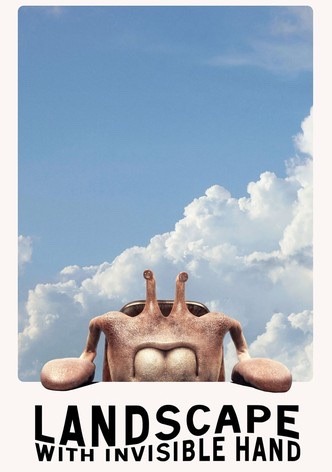
Okay as someone who is EXTREMELY nerdy about non-humanoid aliens depicted in media I LOVED this movie. The Vuvv are super weird, and tiny, and POWERFUL. Incredibly unsexy weird capitalist aliens. Go watch it!
#landscape with invisible hand#speculative biology#speculative evolution#movie nerd#movie critique#science fiction#sci fi#2023 movies#oscars 2024#film critic
16 notes
·
View notes
Photo
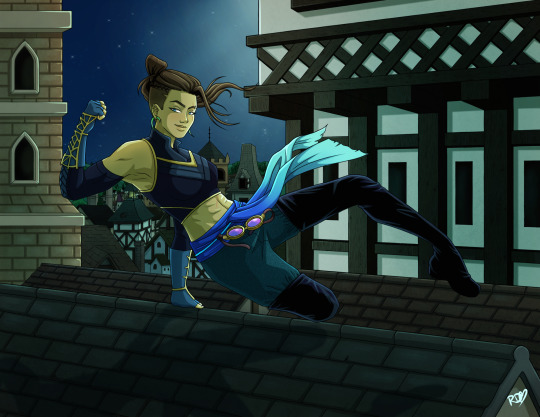
🎵 It’s Thursday night 🎵
#beauregaurd#cr beau#cr beauregard#beauregard lionett#the mighty nein#film critic#critical role fanart
114 notes
·
View notes
Text
the most relatable person in oppenheimer (basing on this scene)




13 notes
·
View notes
Text
“Today I look at Keaton's works more often than any other silent films.
They have such a graceful perfection, such a meshing of story, character and episode, that they unfold like music.
Although they're filled with gags, you can rarely catch Keaton writing a scene around a gag; instead, the laughs emerge from the situation; he was “the still, small, suffering center of the hysteria of slapstick,” wrote the critic Karen Jaehne.
And in an age when special effects were in their infancy, and a “stunt” often meant actually doing on the screen what you appeared to be doing, Keaton was ambitious and fearless. He had a house collapse around him. He swung over a waterfall to rescue a woman he loved. He fell from trains. And always he did it in character, playing a solemn and thoughtful man who trusts in his own ingenuity.”
- Roger Ebert
#buster keaton#roger ebert#silent film#silent comedy#1920s#1920s cinema#golden age of hollywood#silent movies#slapstick#comedy#Karen Jaehne#film critic#movie critic
59 notes
·
View notes
Text
bring me more movies like midsommar, fresh, the menu, movies that are not slasher ones or jump scares, but that psychologically mess with you
9 notes
·
View notes
Text
LISA FRANKENSTEIN Is to Die For
A lonely teen has her undead crush brought back to life, and he just might be the man of her morbid dreams. Written by Diablo Cody and the directorial debut of Zelda Williams, Lisa Frankenstein is an adoringly creepy and unabashedly edgy horror rom-com that’ll make you swoon — and maybe a little grossed out.
Lisa (Kathryn Newton) has recently relocated in her senior year of high school to live…
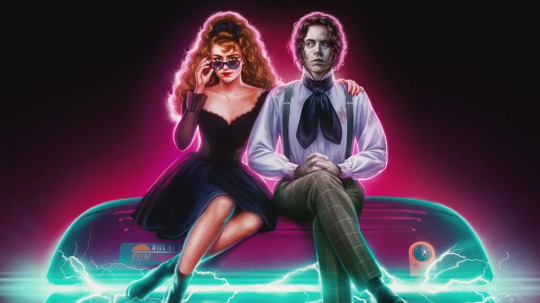
View On WordPress
#carla gugino#cole sprouse#comedy#Comedy Reviews#diablo cody#featured#female film critic#female filmmakers#film blog#film critic#film review#horror comedy#horror film#Horror Reviews#kathryn newton#lisa frankenstein#liza soberano#new in theaters#new movie#new movies#Review#reviews#rom com#Romance Reviews#zelda williams
7 notes
·
View notes